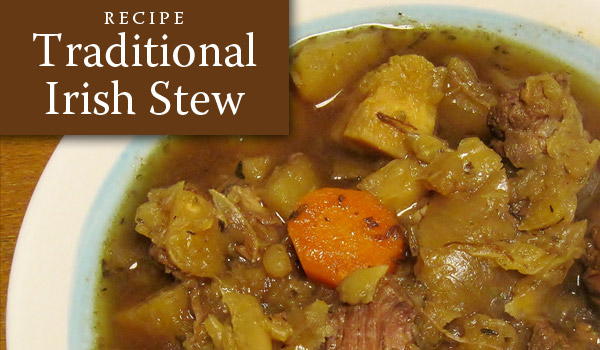Recipe: Traditional Irish Stew for St. Patrick’s Day
Story by Hal Goodtree. Photo by Gloria Cabada-Leman.
Cary, NC – St. Patrick’s Day is coming up this weekend and we’ve already talked about Irish Beer. But what makes a stew Irish?
Recipe: Traditional Irish Stew
Some purists claim that a traditional Irish Stew contains just four ingredients:
- Meat
- Potatoes
- Carrots
- Onions
Cut all the ingredients into small pieces, put the meat and potatoes into the water, add the carrots and onions, maybe a little salt and pepper and it’s done in an hour.
But like many traditions, everyone has their own variation.
Variations: Irish Stew Meat
The first controversy surrounds the meat.
The purists insist on mutton, the older the better. After all, you probably wouldn’t throw tender young lamb into the stew pot.
But stew is designed to be an economical meal (that’s one of the key ingredients), and mutton is expensive in America. So most people use beef.
You can use packaged stew meat from the supermarket. One recipe I read used steak. I have leftover steak in my refridgerator and that’s what I’m going to use.
Interestingly, one of the purists I read mentioned “mince meat.” That’s what we call hamburger or chopped meat in America. The writer suggests rolling into small balls. I’d never heard of meatballs in an Irish Stew, but it makes sense.
So: mutton, beef or meat balls. On CookUK, they recommend lamb chops. One writer mentioned neck bones, but my supermarket doesn’t carry them. Good for stock, but, you know, yuck.
Variations: Irish Stew Vegetables
Carrots, potatoes and onions are the staples of Irish Stew. But many writers mention shredded cabbage.
I would cut the cabbage about the size of the other vegetables and add after the first half hour of cooking.
Many writers also mention garlic. A few cloves can’t hurt.
Other root vegetables are occasionally mentioned, like turnips and parsnip. I guess the stew sometimes came together from whatever was lying around the pantry after a long winter.
Irish Stew Seasonings
Most recipes call for salt and pepper.
Many also mention thyme. A few mention bay leaves, parsley and sage.
Most recipes caution against overuse of spices in Irish Stew. It’s supposed to be a simple dish.
Irish Stew: Guinness or No?
Here’s where the controversy really starts to flair up.
The purists insist that beer is not a traditional ingredient of Irish Stew. But many recipes call for substituting a cup of beer for some of the water. One recipe I read even included a cup of red wine, but that may be going too far. Delicious, but not traditional.
To be frank, the stew broth can be pretty bland on it’s own. For my taste, the addition of a dark beer (Guinness or other) gives the dish some body.
Irish Stew: Thickening
Who likes a watery broth? I don’t.
Some recipes call for using potato water or Pearl Barley to thicken the broth. A few call for flour.
I just like to mash a couple of the potato chunks and let them thicken up the broth.
Hal’s Composite Irish Stew Recipe
Start:
- 2 tbls olive oil
- 1 1/2 lbs cubed beef, lamb, mutton or meat balls. Bones optional for flavor.
- salt & pepper to taste
Cook the meat and onions for two minutes in the bottom of a stock pot. When everything is slightly browned, add the following liquid:
- 4 cups water
- 2 cups stout or dark beer
Add herbs:
- 1 tspn of thyme
- 2 bay leaves
- 2 tbls chopped fresh parsley
- 6 garlic cloves
If the meat is not a tender cut (like lamb or mince meat), simmer for a half hour or more. Otherwise, add the vegetables when the liquid comes to a boil:
- 2 cups carrots, cut chunky
- 4-6 potatoes, peeled and cubed
(Baby potatoes are a nice substitute since you can leave the skins on.)
Cook for half and hour. Check to see how things are going. I usually mash one of the potatoes into the broth at this point.
- Add 1 cup chopped cabbage
Cook for another half hour or until potatoes and carrots are just soft in the center. It helps to cut the carrots chunky so they don’t get done before the potatoes.
Serve in a bowl with a dark, crusty bread.




Comments are closed.